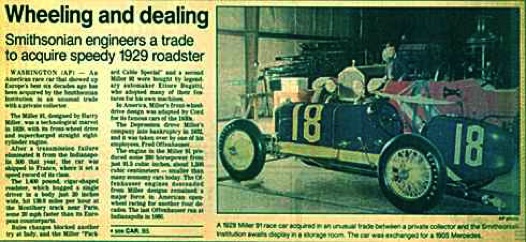about
WASHINGTON (AP) --- An American race car that showed up Europe's best six decades ago has been acquired by the Smithsonian Institution in an unusual trade with a private collector.
The Miller 91, designed by Harry Miller, was a technological marvel In 1929, with its front-wheel drive and supercharged straight eight-cylinder engine.
After a transmission failure eliminated it from the Indianapolis 500 that year, the car was shipped to France, where it set a speed record of its class.
The 1,400 pound, cigar-shaped roadster, which hugged a single driver just 20 inches wide, hit 139.6 miles per hour at the Montlhery track near Paris, some 20 mph faster than its European counterparts.
Rules changes blocked another try at Indy, and the Miller "Packard Cable Special" and a second Miller 91 were bought by legendary automaker Ettore Bugatti, who adopted many of their features for his own machines.
In America, Miller's front-wheel drive design was adapted by Cord for its famous cars of the 1930s.
The depression drove Miller's company into bankruptcy in 1932, and it was taken over by one of his employees, Fred Offenhauser.
The engine in the Miller 91 produced some 280 horsepower from just 91.5 cubic inches, about 1,500 cubic centimeters--smaller than many economy cars today. The Offenhauser engines descended from Miller designs remained a major force in American open-wheel racing for another four decades. The last Offenhauser ran at Indianapolis in 1980.
Of the 12 Miller 91s built, only five are known to exist and only two are considered very authentic. The Smithsonian now has one, and the other good example is at the Indianapolis Motor Speedway's Museum.
The "Packard Cable Special" was donated by Robert Rubin of Southampton, N.Y., along with a $100,000 grant for the motorsports collection at the Smithsonian's National Museum of American History, the museum said.
But there was a catch.
In exchange for the Miller, which Rubin had meticulously restored to original condition, Rubin wanted a 1905 Mercedes that the museum had in storage.
Despite a policy that weighs strongly against such arrangements, the deal was made. William L. Withuhn, the curator of the collection, said it only happened because the museum had already considered the Mercedes as possibly unsuitable for its purposes.
"It required more conservation , correction and restoration than we could ever afford," he said.
Some private collectors who were aware of the transaction said the Mercedes was probably worth more than $1 million and the Miller several times that amount.
Withuhn declined to discuss the dollar values, and added that it would not have mattered if the Mercedes was considered a needed part of the collection.

The Times
Sunday, January 12, 1992

Press
